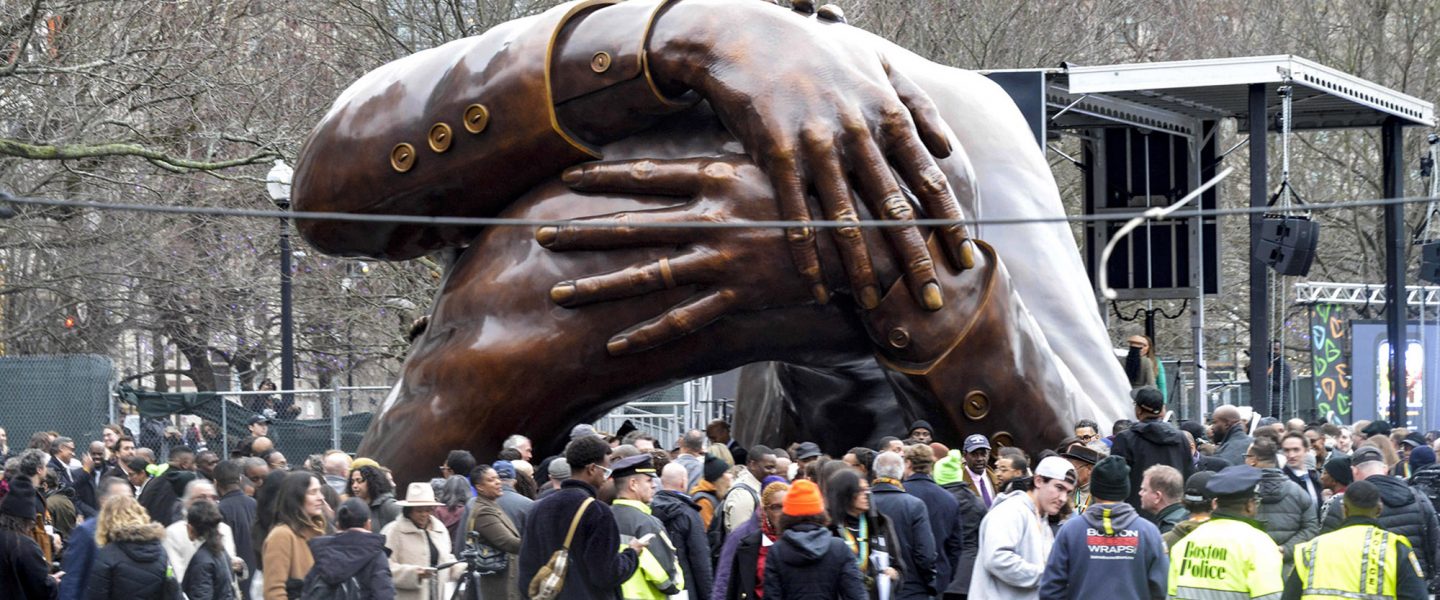Does it deserve to be called the $10 million “woke penis sculpture?”
|
Listen To This Story
|
According to many news reports, no one much likes the new Martin Luther King sculpture in Boston.
The Washington Post declared it “draws online mockery [and] disdain.”
The New York Post labeled it a $10 million “woke penis sculpture,” gleefully quoting outrage from “kin of Coretta Scott King,” one of whom obligingly opined that it “looks like a penis,” allowing the tabloid to trumpet the appendage in its headline.
Even the avuncular and serious-minded Art Newspaper wrote that the sculpture had received “mixed reviews.”
Mixed? Comedian Javann Jones tweeted, “Show me a white man that was honored with a statue of only two of his limbs.”
And Coretta Scott King’s non-comedian cousin Seneca Scott (he’s the “kin” mentioned in The New York Post) fired off a salvo in print, critiquing the work as “A Masturbatory ‘Homage’ to My Family.” That’s the title of his piece. He politicized the work as a left-wing plot: “This sculpture is an especially egregious example of the woke machine’s callousness and vanity. Hopefully, it will show more black people that these progressives just aren’t in this for our benefit.”
Well sorry, folks, but I like it.
Called “The Embrace,” the sculpture is by Hank Willis Thomas, an internationally recognized Black artist with work exhibited around the world as well as throughout the United States. The piece is inspired by a photograph of Martin Luther King and Coretta Scott King embracing after the civil rights leader won the Nobel Peace Prize in 1964. Thomas has said, “I saw in that moment, how much of his weight was literally on top of her. And I thought that was a really symbolic idea: That she was literally holding his weight.”
The work is made of over 600 separate bronze parts, and at 20 feet high and 25 feet wide, it looks welcoming to me, participatory in the sense that you can walk under and around it. From various angles it appears completely different, abstract from one side, representational from another.
I don’t have any data on this, but I wouldn’t be surprised if children “get” it more easily than adults do, enchanted by its impossible size and embracing limbs. Children are used to being hugged, and I think they’ll respond to the expressed love in the work.
A recurring criticism seems to be of the disembodied arms, the lack of torsos or heads. Would these critics recoil at Picasso’s cubist faces or question de Kooning’s painting of Marilyn Monroe? These strike me as reactionary concerns channeling basic artistic controversies settled decades ago.
 The connection to the Kings is explained at its base, where plaques honoring local civil rights leaders encircle the piece, but its absence of faces contributes to its universality. To my mind it conveys the propagation of Martin Luther King’s message of love.
The connection to the Kings is explained at its base, where plaques honoring local civil rights leaders encircle the piece, but its absence of faces contributes to its universality. To my mind it conveys the propagation of Martin Luther King’s message of love.
I’m old enough to remember the odium heaped on Maya Lin’s Vietnam War Memorial when it was unveiled in 1982. Now it’s one of the most-loved attractions in Washington, DC, but at the time it was attacked as a “black gash of shame” and a “degrading ditch.”
Likewise, the Empire State Building, the Guggenheim Museum, even the Eiffel Tower were all condemned at their openings. The first night of Stravinsky’s Rite of Spring famously caused a riot, and in 1949 when Life magazine asked rhetorically if Jackson Pollock was “the greatest living painter in the United States,” the implied answer was “no.”
But times change, and all of those works of art, those buildings and compositions are now embraced so much by our culture, they’re taken for granted.
Will Thomas’s sculpture be as embraced as its own depiction? For the time being it’s embracing itself in the absence of outside approval. But I wouldn’t be surprised if the city of Boston eventually let down its guard, and joined that enormous and heartfelt hug.
—
J.B. Miller is an American writer living in England, and is the author of My Life in Action Painting and The Satanic Nurses and Other Literary Parodies.




